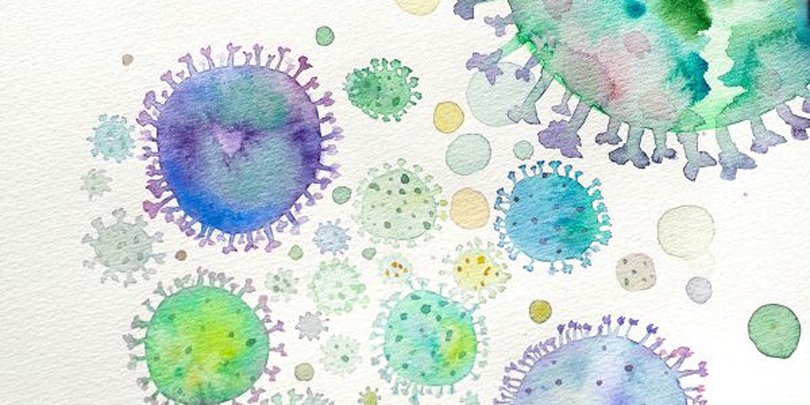At this time of national and international pandemic crisis, Newsbriefing has called on BAAT members to reflect on how they are responding to the many radical and unprecedented changes to work practices that we are experiencing as art therapists as a result of this massive health emergency.
In March 2020, many complementary therapists and allied health professionals suddenly found themselves on the frontline providing essential and life saving services. Art therapists were also called upon to provide mental health support to colleagues working in stressful conditions as well as patients and families affected by the Coronavirus. Others experienced abrupt endings with clients, in some cases with no endings or access to follow-up contact, particularly for therapists working with children in mainstream education and the voluntary sector. Many therapists in mental health services were instructed to provide counselling, psychotherapy and art therapy online within a matter of days, and where art therapists were able to see clients and in some cases continue to run groups, the protocols around distancing and safe practice varied, with some wearing personal protective equipment (PPE) and others providing individual art packs and maintaining a safe distance.
We will use this special section of Newsbriefing to reflect on what we are learning about safe and best practice, whilst also looking at new and creative responses that art therapists are developing during this ongoing and developing international crisis.
Introduction from Val Huet
Since March 2020, everyone in the UK has lived in what Professor Huss has described as a ‘shared-reality crisis’ (2020). At BAAT, from mid-February we closely watched international news which became more alarming as days went by. Many of us have family and friends in countries which experienced the effects of the pandemic earlier than the UK and doubted that we would escape a crisis of enormous proportion. Therefore, in the week of 9th March and despite government advice at that time to carry on as normal, we decided to cancel all in-person events and asked regional and special interest groups to do the same. The implications of the new reality dawned quickly: many BAAT members would lose work, service users would lose access to essential support and services, and the looming professional and personal isolation would have serious consequences for everyone.
As Professor Huss stated (2020), one of the consequences of a shared-reality crisis is that no one is an expert on how to address this: issues often do not stay static but continue to change and present new challenges. BAAT’s stance was that we were all learning together and that the best way of doing this would be to work in collaboration, and partnership with members, service users, carers and other organisations. We partnered with the British Association of Music Therapists and the British Association for Dramatherapy to pool resources, exchange news and updates, and share guidance for members.
It soon became clear that lockdown called for new skills and approaches: the world of online practice was not one most BAAT members were familiar with. Our usual familiar constructs, such as the art therapy space, confidentiality, art-making during the session, etc., had to be reassessed and adapted. This, in turn, raised issues of self-care, as we soon discovered that this new way of working could be exhausting. The series of free BAAT lectures were organized to support BAAT members to learn new skills, share practice approaches and generally feel connected to each other and to BAAT.
As Gary Nash and I had been working with these issues in our different contexts, we thought it would be important to ask BAAT members to share their experiences for this special section and we are immensely grateful for the generous responses included in this issue. This is not the end of this process: we need to understand the shape of what is called the ‘New Normal’. We do not think that, even with a relaxation of social distancing and lockdown, we will see a return to things as they were before March 2020: online art therapy practice is unlikely to disappear as it has facilitated more equal access.
Furthermore, as we write, Black Lives Matter has highlighted the devastating impact of racism and inequalities, and we need to understand how this was reflected in the disproportionate impact of the pandemic on the BAME community. We aim to continue this learning in our next issue and to include reflections and articles on all these issues.
Introduction from Gary Nash
As therapists we are trained and experienced to work with uncertainty, change, transition and adaptation, and some have additional training to work with shock, fear, anxiety and trauma in their daily clinical work; many also work with loss and grief.
The effects of the shock and trauma that we are experiencing now as individuals, families, communities, a nation, a species, is similar to the shock and trauma which some therapists are trained and experienced in working with. The methods that have emerged from the research with post-traumatic stress disorder (Van der Kolk, 2015) can be utilised when working with the impact that sudden and traumatic change can have on individuals. On a somatic level we work with the body’s own coping reactions, and use methods to support the regulation of powerful affects, such as fear and panic through supporting affect regulation and the use of the breath, relaxation and mindfulness, combined with body gesture and movement extended into art-making.
In the current health emergency, there is an additional complexity as we work with and live through a new phenomenon – collective trauma. Trauma of this magnitude is difficult to comprehend, the threat is not visible and yet we are required to moderate our behaviour and social interactions in ways that may heighten suspicion and activate projections of our fear onto others. These massive social and cultural changes are driven by an underlying threat to life and this threat can generate fear which often fuels collective shock and panic reactions.
Perini (2018) describes how a biological outbreak is often followed by a psychological outbreak of fear, suspicion, panic and stigma – followed by social and politically sanctioned changes in cultural and social behaviour:
“The fear of contagion and infectious epidemics has some very specific characteristics. One is the fear of the invisible, something that is among us but cannot be seen, because it is too little (like bacteria and viruses), too big (like pollution, radioactivity, stock market, or an epidemic process), or homely and familiar, like air, water, food, the next-door neighbour, the members of our family. The core unconscious fantasy in the fear of epidemics is that “the enemy is among us or even one of us”. Its hallmark is a set of paranoid defences, involving split (between the guilty and the innocent, the pure and the contaminated) and projection of guilt and blame on individuals and groups supposed responsible for contagion” (Perini, 2012, p.8).
As we, as a society, comply with politically sanctioned restrictions in order to preserve life and manage the outbreak in a controlled way, there is an emotional and mental health impact. In terms of the ongoing and unfolding spread of infection, and the fear of being infected, our social relationships, cultural and creative connections, and personal freedoms and liberties, are necessarily restricted and we are confined to our home environments. The social disruption that coronavirus is causing in our daily lives raises questions around the important part we play as art therapists. The work that we are now engaged in, whether in face-to-face services or through art therapy online, will support our clients and colleagues with the impact that social isolation and confinement is having upon emotional well-being and our mental health. Current research initiated by Glasgow University is looking at the impact of self-isolation and the pre-disposing factors that might heighten risk of depression, anxiety and suicide and it is envisaged that there will be a growing need for extensive responsive counselling and therapy services during ‘lockdown’ and for the long-term recovery period.
The article written by Italian colleague, art therapist and psychotherapist Estella Guerrera, reflects on the immediate impact the current crisis is having on our lived experience, and considers what art therapists can contribute. At this time, when we have drastically reduced access to the arts, human relationships and nature, she examines how art therapists have responded in the past, and what our current responses might look like. Estella draws on her experiences in humanitarian aid work and provides a review of previous research and practice in this area.
The sudden and abrupt transfer of ongoing art therapy to an online service has affected many art therapists, counsellors and psychotherapists across all services and age groups. BAAT has responded with guidance and access to online training. Many therapists, trainees, services and training providers have responded by developing protocols, and drawing on research in the area of tele-health and tele-counselling (Jones, 2017). As we develop a new skill set and competencies in this area we are finding that beyond the initial technical questions around which digital platform and secure provider to use, we are finding other, more complex, questions around boundaries and relational dynamics that are unique to this digital interface format.
The second article is by UK and Spain-based art therapist Sophie Benoit, who is currently researching her work using online art therapy. Sophie has been using what she describes as a ‘blended method’ that uses face-to-face and online art therapy, which enables her to work in both countries. Sophie has been asked to reflect on her work using online technology and draws on her many years of experience in this area. She provides a balanced view of research, practice, relational dynamics and some technological perspectives on this way of working.
The following article is by Amy Johnson and Mary Harris, and describes how they work through the ethical and technical difficulties, issues and obstacles when working online with children, Mary in mainstream primary in Greater Manchester, and Amy in a Special Educational Needs setting in Birmingham with 4-18 year olds.
Art Therapists Gillian W Datlen and Chiara Pandolfi describe the adaptation of an open studio art therapy group to an inclusive online platform. They focus on the process of moving to an online format and describe several sessions highlighting themes of loss, separation and the containment of a planned online ending.
A final focus on innovative use of online art therapy services is written by community-based art therapist Vivienne Gibbons, who has developed the ‘chatncheckin’ and ‘Virtual Cuppa’ groups in Leeds.
The nature of collective trauma, which is unique to this situation, is that we all experience the effects, we all have relatives or loved one’s who are at risk, and in our day-to-day work and visits to the shops we too are at risk. As practitioners we carry our own personal concerns, heightened levels of anxiety, personal fear of exposure and concern for others, along with our professional care, concern and empathy for those we work with. It is essential therefore that our own safety, personal self-care and access to resources that build our personal and professional resilience are given our full attention. An article on digital self-care and professional peer support is the focus of the article written by Art Therapists Emily Clemson and Catherine Rogers.
The interview with art psychotherapist Michèle Wood, written by Diana Kayafa (art psychotherapist) focuses on the impact of the lockdown on Michèle’s daily working conditions and her views on the impact of the pandemic on art psychotherapy work. In this interview, Michèle describes the immediate impact of Covid-19 on her practice in her work with a high-risk vulnerable patient group, where art therapy continues with full personal protective equipment (PPE) and social distancing, and her research in digital health interventions for this client group and their families.
The final article is an online practice guidance working document introduced by Val Huet, taken from Sophie Benoit’s work, complied by Gary Nash, and referenced to Cathy Malchiodi’s (2000) comprehensive work in this area.
References
Jones, G. (2017) Providing Art Therapy in Palliative Care using Telehealth Technology in: Newsbriefing, April edition. London: British Association of Art Therapists.
Huss, E. (2020): BAAT Zoom lecture on Art Therapy Online in Times of Community Crisis
Malchiodi, C. A., (2000) Art Therapy and Computer Technology: a virtual studio of possibilities. London: Philadelphia: Jessica Kingsley Publishers.
Perini, M. (2018) ‘Panic and Pandemics: from fear of contagion to contagion of fear’ in Brunning, H. (ed,) (2018) Psychoanalytic reflections on our changing world. London: New York; Routledge.
Van der Kolk, B. (2015) The Body Keeps the Score. St Ives: Penguin Books.
Copyright (c) The British Association of Art Therapists (BAAT)
This article is published in BAAT Newsbriefing Summer 2020 and may not be distributed or published without the consent of BAAT


